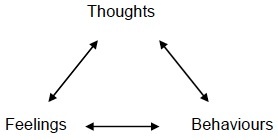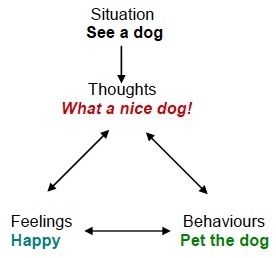CBT, or cognitive-behavioural therapy, is a psychological treatment that was developed through scientific research. That is, all of the components of CBT have been tested by researchers to determine whether they are effective and that they do what they are intended to do.
On this page: |
Research has shown that CBT is one of the most effective treatments for the management of anxiety. The good news is that although it is best done with a trained CBT therapist, you can apply CBT principles at home to manage your own anxiety and conquer your fears.
What are the principles of CBT?
CBT involves learning new skills to manage your symptoms. It teaches you new ways of thinking and behaving that can help you get control over your anxiety in the long-run. There are a few principles that are important to understand when using CBT.
1. CBT focuses on the here and now.
An important principle of CBT is that treatment involves dealing with the symptoms that you are struggling with right now, rather than focusing on the cause of your problem. Although it can be interesting to understand how your anxiety developed, just knowing why you have anxiety problems is often not enough to help you manage your anxiety.
Here is an example: Imagine that you are terrified of dogs. Every time you see one, you run the other way, because you are convinced that all dogs are vicious beasts that will bite you. Now, if you wanted to understand why you are so afraid of dogs, you might eventually find out that you were bitten by a dog when you were a child, which is no doubt the cause of your fear of dogs.
Here's the problem: Knowing the cause does not change the fact that you are terrified of dogs, running away from them, and thinking of them as vicious beasts that bite.
2. CBT emphasizes the importance of homework
Whether you are receiving CBT from a trained therapist or you are using self-help CBT techniques at home, homework is a key component. Doing homework for CBT basically means that from week to week, you will need to practise the new skills that you are learning and apply them to your daily life. And like the homework that you were given in school, you need to practise those skills every day.
Why is homework so important?
Unless you practice the new strategies that you learn to manage anxiety, you will not use them very well, and you will probably forget to use them when you need them most: when you are feeling very anxious.
Learning new ways to manage anxiety is a little like developing a new healthy habit. If for example, you wanted to start exercising regularly, you would want to fit in a new exercise routine into your schedule. It would be difficult at first, but if you kept at it, that new routine would become a habit, and eventually a part of your regular activities. The same is true with CBT skills: if you practise them every day, they will become a part of your daily routine.
The good news is that the more you use your CBT skills, the easier it gets, and the better you will become at managing your anxiety.
What to expect if you see a CBT therapist
-
CBT is structured and educational: Treatment sessions in CBT involve learning new ways to think about and understand your symptoms. Because of this, sessions are structured so that you are usually reviewing the homework you did, learning new information and skills, and then developing a new homework assignment for the next session.
-
CBT is collaborative: Because you are learning new skills in CBT, therapy is very active. Both you and your therapist will be working on helping you to understand your symptoms and ways to manage them. You can expect to participate both in and out of session in order to see positive changes.
-
CBT is time-limited: People who go to see a CBT therapist to help them with their anxiety will usually have between 8 to 20 sessions. CBT is not supposed to be a life-long process. Rather, you are learning to become your own therapist. Once you have learned new skills, had a chance to master them and see positive changes in your life, it will be time for you to leave therapy and continue managing your anxiety on your own.
Keep in mind: When it comes to CBT, you get out of it what you put in. If you don’t put your best effort into managing your own anxiety, you probably won’t get as much benefit from CBT as you could.
What will I learn in CBT?
CBT involves learning how to change your thoughts (also called cognitions) and your actions (or behaviours), which is why it is called cognitive-behavioural therapy. Why is this important? Because in any given situation, you will have thoughts and feelings about it, and behave in a certain way. These thoughts, feelings, and actions all interact and influence each other. The best way to understand this is to think about them as a triangle:

Returning to our example of a fear of dogs, imagine a situation where you are walking down the street and you see a dog. You might expect to feel afraid, to think that the dog will bite, and to run away or avoid the dog in some way. In our triangle, it would look like this:

However, if we imagine that you have a friend who is not afraid of dogs and actually likes them very much, your friend’s thoughts, feelings, and actions might be very different:

Remember: One thing to notice in these two examples is that the situation did not change: but if you change your thoughts, then your feelings and actions change as well.
If we return to the first example, you might be able to reduce your fear of dogs if you either:
Change your reactions (behaviour):
By facing your fears through gradual exposure, you could slowly reduce the anxiety experienced when faced with your anxiety trigger. Avoidance is a typical reaction to the things we fear that gives us relief in the short term. Relying on this strategy and avoiding our anxious triggers however not only maintains our anxiety, but it actually makes us more anxious and sensitive to our triggers over time. Exposure is one of the best tools at your disposal to face your fears and manage your anxiety in the long run (see Facing Your Fears—Exposure).
You can enhance your exposure exercises by testing your anxious beliefs when you face your fears as well. When you avoid your anxious triggers or rely on strategies to "make sure" your fears don't come true (eg. washing hands excessively, spending extra time scanning an email to make sure there aren't any mistakes), you begin to believe that the only reason your fears didn't come true is because of those strategies. If you applied this to the example of slowly confronting dogs that you are afraid of, over time your fear of dogs would be reduced, and you would learn that not all dogs bite.
OR
Change your thoughts (cognitions):
You might also change the triangle if you were able to challenge the thought that all dogs bite. For example, you might tell yourself that if all dogs were vicious and bit people, no one would have them as pets. When we feel anxious, our thinking tends to be overly negative, because it is completely focused on danger and threat: we don’t always see the whole picture.
If you are afraid of dogs, for example, when you see a dog you might only be thinking about how sharp his teeth look and not about whether he is on a leash or if his tail is wagging. Learning to take a closer look at your thoughts, and coming up with more balanced and realistic thoughts, is another important tool for managing your anxiety (see Realistic Thinking for more information).
Key points to remember:
-
CBT, or cognitive-behavioural therapy, is based on research—so we know it works!
-
CBT teaches you new ways of thinking and behaving.
-
Thoughts, feelings, and behaviours are interconnected, so if you change one, it has an effect on the other two.
-
If you change the way you think and behave, you can also change the way you feel.
About the author

Anxiety Canada worked to promote awareness of anxiety disorders and increase access to proven resources. The organization closed in April 2025 but their website is still available at www.anxietycanada.com.
Thank you to Anxiety Canada's Registered Clinical Counsellor and Clinical Educator Mark Antczak for reviewing this resource in 2022.
